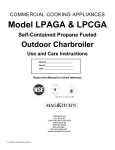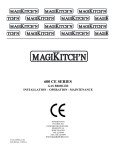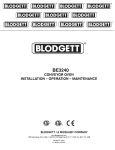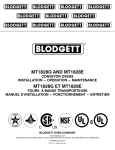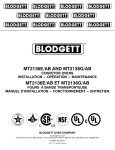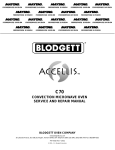Download Blodgett MT1820E Specifications
Transcript
MT1820E CONVEYOR OVEN INSTALLATION -- OPERATION -- MAINTENANCE BLODGETT OVEN COMPANY www.blodgettcorp.com 50 Lakeside Avenue, Box 586, Burlington, Vermont 05402 USA Telephone (800) 331-5842, (802) 860-3700 Fax: (802)864-0183 PN M7260 Rev D (6/01) E 2000 --- G.S. Blodgett Corporation IMPORTANT WARNING: IMPROPER INSTALLATION, ADJUSTMENT, ALTERATION, SERVICE OR MAINTENANCE CAN CAUSE PROPERTY DAMAGE, INJURY OR DEATH. READ THE INSTALLATION, OPERATING AND MAINTENANCE INSTRUCTIONS THOROUGHLY BEFORE INSTALLING OR SERVICING THIS EQUIPMENT FOR YOUR SAFETY Do not store or use gasoline or other flammable vapors or liquids in the vicinity of this or any other appliance. The information contained in this manual is important for the proper installation, use, and maintenance of this oven. Adherence to these procedures and instructions will result in satisfactory baking results and long, trouble free service. Please read this manual carefully and retain it for future reference. Errors: Descriptive, typographic or pictorial errors are subject to correction. Specifications are subject to change without notice. THE REPUTATION YOU CAN COUNT ON UNE RÉPUTATION SUR LAQUELLE VOUS POUVEZ COMPTER For over a century and a half, The Blodgett Oven Company has been building ovens and nothing but ovens. We’ve set the industry’s quality standard for all kinds of ovens for every foodservice operation regardless of size, application or budget. In fact, no one offers more models, sizes, and oven applications than Blodgett; gas and electric, full-size, half-size, countertop and deck, convection, Cook’n Hold, Combi-Ovens and the industry’s highest quality Pizza Oven line. For more information on the full line of Blodgett ovens contact your Blodgett representative. Model: Your Service Agency’s Address: Serial Number: Your oven was installed by: Your oven’s installation was checked by: Table of Contents Introduction Oven Description and Specifications . . . . . . . . . . . . . . . . . . . . . . . . . . . . . . . . Oven Components . . . . . . . . . . . . . . . . . . . . . . . . . . . . . . . . . . . . . . . . . . . . . . . 2 3 Installation Delivery and Inspection . . . . . . . . . . . . . . . . . . . . . . . . . . . . . . . . . . . . . . . . . . . Oven Location and Ventilation . . . . . . . . . . . . . . . . . . . . . . . . . . . . . . . . . . . . . Oven Assembly . . . . . . . . . . . . . . . . . . . . . . . . . . . . . . . . . . . . . . . . . . . . . . . . . . Utility Connections --- Standards and Codes . . . . . . . . . . . . . . . . . . . . . . . . . Electrical Connection . . . . . . . . . . . . . . . . . . . . . . . . . . . . . . . . . . . . . . . . . . . . . 4 5 6 9 10 Operation Safety Information . . . . . . . . . . . . . . . . . . . . . . . . . . . . . . . . . . . . . . . . . . . . . . . . Oven Operation . . . . . . . . . . . . . . . . . . . . . . . . . . . . . . . . . . . . . . . . . . . . . . . . . . Oven Adjustments for Cooking . . . . . . . . . . . . . . . . . . . . . . . . . . . . . . . . . . . . . 11 12 13 Maintenance Cleaning . . . . . . . . . . . . . . . . . . . . . . . . . . . . . . . . . . . . . . . . . . . . . . . . . . . . . . . . Component Locations . . . . . . . . . . . . . . . . . . . . . . . . . . . . . . . . . . . . . . . . . . . . Troubleshooting Guide . . . . . . . . . . . . . . . . . . . . . . . . . . . . . . . . . . . . . . . . . . . . 14 15 16 Introduction Oven Description and Specifications Cooking in a conveyor oven differs from cooking in a conventional deck or range oven since heated air is constantly recirculated over the product by a fan in an enclosed chamber. The moving air continually strips away the layer of cool air surrounding the product, quickly allowing the heat to penetrate. The result is a high quality product, cooked at a lower temperature in a shorter amount of time. Blower Air Plate Conveyor Air Plate Blodgett conveyor ovens represent the latest advancement in energy efficiency, reliability, and ease of operation. Heat normally lost, is recirculated within the cooking chamber before being vented from the oven: resulting in substantial reductions in energy consumption, a cooler kitchen environment and enhanced oven performance. Heating Elements Air Flow Pattern for Blodgett Conveyor Ovens Figure 1 MT1820E SPECIFICATIONS Belt Width 18” (46 cm) Cooking Zone Length 20” (51 cm) Baking Area 2.6 Sq. Ft. (0.24 m2) Dimensions (single unit) 42” x 32” x 16” (107 cm x 81 cm x 41 cm) Maximum Input 8.0 KW/Hr. Maximum Operating Temperature 550_F (288_C) Power Supply U.S. and Canadian Installations 208 VAC, 1Φ, 60 Hz, 38.46 Amp 240 VAC, 1Φ, 60 Hz, 33.33 Amp Export Installations 220 VAC, 1Φ, 50 Hz, 36.36 Amp 230 VAC, 1Φ, 50 Hz, 34.85 Amp 240 VAC, 1Φ, 50 Hz, 33.33 Amp 400 VAC, 3Φ, 50 HZ, L1=16 amps, L2=8 amps, L3=9.5 amps, N=8 amps Product Clearance 3.0” (7.62 cm) 2 Introduction Oven Components Baking Chamber --- products pass through the baking chamber on the conveyor belt for cooking. Conveyor Belt Assembly --- stainless steel chain link (conveyor) belt and support that carries product through the oven. Crumb Pan --- catches crumbs from products on the conveyor. Located under conveyor belt at both ends of the baking chamber. Control Box --- contains electrical wiring, cooling fan or louvers, drive motor and drive chain. Air Flow Plates --- distribute heated air to top of baking chamber. Located inside of oven at the top and bottom of baking chamber. Drive Motor --- provides power to move the conveyor belt. Drive Belt --- connects the drive motor sprocket to the drive side conveyor belt support sprocket. Control Box Product Stop Conveyor Assembly (shown without belt) Crumb Pans Figure 2 3 Installation Delivery and Inspection The oven can now be moved to the installation site. Check the following list with Figure 2 on page 3 to be sure all items were received. All Blodgett ovens are shipped in containers to prevent damage. Upon delivery of your new oven: D D Inspect the shipping container for external damage. Any evidence of damage should be noted on the delivery receipt which must be signed by the driver. Uncrate the oven and check for internal damage. Carriers will accept claims for concealed damage if notified within fifteen days of delivery and the shipping container is retained for inspection. Part Description The Blodgett Oven Company cannot assume responsibility for loss or damage suffered in transit. The carrier assumed full responsibility for delivery in good order when the shipment was accepted. We are, however, prepared to assist you if filing a claim is necessary. 4 Qty. Main oven body 1 Conveyor belt assembly 1 Crumb pan 2 Packet containing: 1/2-13 alignment pins for oven supports 1 Packet containing: flat washers for oven supports 1 Owner’s manual 1 Product stop (available in 0” or 12”) 1 Installation Oven Location and Ventilation LOCATION VENTILATION The well planned and proper placement of your oven will result in long term operator convenience and satisfactory performance. U.S. and Canadian installations Refer to your local ventilation codes. In the absence of local codes, refer to the National ventilation code titled, “Standard for the Installation of Equipment for the Removal of Smoke and Grease Laden Vapors from Commercial Cooking Equipment”, NFPA-96-Latest Edition. The following clearances must be maintained between the oven and any combustible or non-combustible construction. D D Oven body sides --- 16” (41cm) Oven body back --- 0” (0cm) General export installations The following clearances must be available for servicing. D D Installation must conform with Local and National installation standards. Local installation codes and/or requirements may vary. If you have any questions regarding the proper installation and/or operation of your Blodgett oven, please contact your local distributor. If you do not have a local distributor, please call the Blodgett Oven Company at 0011-802-860-3700. Oven body left side --- 38” (97cm) Oven body back --- 28” (71cm) Oven models having casters can be rolled away from the wall for servicing. If the oven needs to be moved further from the wall, power must first be turned off and disconnected from the oven. D D D D Place the oven in an area that is free of drafts. Keep the oven area free and clear of all combustibles such as paper, cardboard, and flammable liquids and solvents. Do not place the oven on a curb base or seal to a wall. Tripping the blower motor’s thermal overload device indicates an excessive ambient temperature at the back of the oven. This condition must be corrected to prevent permanent damage to the oven. All motor bearings are permanently lubricated by the manufacturer. There is no need for additional lubrication during the operational lifetime of the motors. WARNING: Failure to properly vent the oven can be hazardous to the health of the operator and may result in operational problems, unsatisfactory baking and possible damage to the equipment. Damage sustained as a direct result of improper ventilation will not be covered by the Manufacturer’s warranty. 5 Installation Oven Assembly LEGS OVEN STAND WITH CASTERS 1. Lay the oven on it’s back. Screw one leg into each of the four holes located on the bottom of the oven chamber. 2. Tighten the hex nut at the top of each leg. 3. Lift the oven upright onto the legs. 1. Attach each leg to the stand frame with a lock washer and nut. DO NOT tighten completely. 2. Position the shelf between the legs with the smooth surface facing the top of the stand. Align the shelf with the holes in each leg. Attach the shelf to each leg with a nut and bolt. 3. Tighten the bolts installed in step 1. 4. Place the oven onto the stand. Bolt the oven to the stand from underneath. Bottom of Oven Leg Stand Frame Top of Stand Figure 3 Shelf Figure 4 6 Installation Oven Assembly STACKING THE OVENS Bottom Oven 2. Attach the heat shield brackets to the bottom of the control box of the upper oven with the screws provided. 3. Carefully lift the upper oven off the pallet and place it on the lower oven. Be sure the alignment pins are inserted into the holes in the top of the lower oven. 4. Slide the heat shield into the brackets. 1. Install the legs, as directed. 2. Attach the stacking rail to the back of the control compartment. Top Oven(s) 1. Rest the oven on it’s back. Install an oven alignment pin into each of the four holes in the bottom of the oven. Heat Shield Heat Shield Brackets Stacking Rail Alignment Pin Top Oven Bottom Oven Figure 5 7 Installation Oven Assembly CONVEYOR 1. Slide the conveyor assembly through the left hand tunnel opening until the sprocket is inside the control box. See Figure 6. 2. Install the drive belt on the motor and then around the pulley on the conveyor assembly. See Figure 7. Pull the conveyor assembly back to tighten the belt. Unless specified otherwise, conveyor travel is factory set for left to right operation when facing the front of the oven. To reverse the direction of the drive motor (if necessary), exchange A1 and A2. WARNING!! Disconnect the power supply before reversing the drive motor. CRUMB PANS 1. Install the crumb pans on both ends of the conveyor. Figure 6 Figure 8 Figure 7 8 Installation Utility Connections --- Standards and Codes U.S. and Canadian installations THE INSTALLATION INSTRUCTIONS CONTAINED HEREIN ARE FOR THE USE OF QUALIFIED INSTALLATION AND SERVICE PERSONNEL ONLY. INSTALLATION OR SERVICE BY OTHER THAN QUALIFIED PERSONNEL MAY RESULT IN DAMAGE TO THE OVEN AND/OR INJURY TO THE OPERATOR. All ovens, when installed, must be electrically grounded in accordance with local codes, or in the absence of local codes, with the National Electrical Code, ANSI/NFPA 70 ---Latest Edition and/or Canadian National Electric Code C22.2 as applicable. General export installations Qualified installation personnel are individuals, a firm, a corporation, or a company which either in person or through a representative are engaged in, and responsible for: Installation must conform with Local and National installation standards. Local installation codes and/or requirements may vary. If you have any questions regarding the proper installation and/or operation of your Blodgett oven, please contact your local distributor. If you do not have a local distributor, please call the Blodgett Oven Company at 0011-802-860-3700. the installation of electrical wiring from the electric meter, main control box or service outlet to the electric appliance. Qualified installation personnel must be experienced in such work, familiar with all precautions required, and have complied with all requirements of state or local authorities having jurisdiction. D 9 Installation Electrical Connection Before making any electrical connections to this unit, check that the power supply is adequate for the voltage, amperage, and phase requirements stated on the rating plate. A wiring diagram accompanies this manual and is also attached to the inside of the control box. L1 Supply L2 208/240 Oven U.S. and Canadian installations Electrically-fired models are equipped for operation on 208 or 240VAC, 1Φ, 60Hz, 2 wire grounded circuits. The oven is equipped with a 50 amp cord set. U.S. and Canadian Installations General export installations The export models are available in either single or three phase. The single phase oven is equipped for operation on 220, 230 or 240 VAC, 50HZ., 2 wire grounded circuits. The three phase units are equipped for operation on 400 VAC, 50HZ, 4 wire grounded circuits. Wiring from the power source to any of these units must be a minimum of #10 AWG (5.26 mm2) copper stranded wire or larger. L1 Supply L2 220/230/240 Oven Single Phase Ovens L1 WARNING!! L2 Incorrect single phase wiring will result in extensive damage to electrical components and possible fire in the control box. THE BLODGETT OVEN COMPANY CANNOT ASSUME RESPONSIBILITY FOR LOSS OR DAMAGE SUFFERED AS A RESULT OF IMPROPER INSTALLATION. Supply 400 L3 Three Phase Ovens General Export Installations Figure 9 10 Oven Operation Safety Information THE INFORMATION CONTAINED IN THIS SECTION IS PROVIDED FOR THE USE OF QUALIFIED OPERATING PERSONNEL. QUALIFIED OPERATING PERSONNEL ARE THOSE WHO HAVE CAREFULLY READ THE INFORMATION CONTAINED IN THIS MANUAL, ARE FAMILIAR WITH THE FUNCTIONS OF THE OVEN AND/OR HAVE HAD PREVIOUS EXPERIENCE WITH THE OPERATION OF THE EQUIPMENT DESCRIBED. ADHERENCE TO THE PROCEDURES RECOMMENDED HEREIN WILL ASSURE THE ACHIEVEMENT OF OPTIMUM PERFORMANCE AND LONG, TROUBLE-FREE SERVICE. Please take the time to read the following safety and operating instructions. They are the key to the successful operation of your Blodgett conveyor oven. 11 SAFETY TIPS For your safety read before operating General safety tips: D D If the oven needs to be moved for any reason, the supply cord must be disconnected from the unit before removing the restraint cable. Reconnect the restraint after the oven has been returned to its original location. DO NOT remove the control box cover unless the oven is unplugged. Operation Oven Operation CONTROLS DESCRIPTION HEAT INDICATOR light (2) cycles on and off with the demand for heat. 3. Press and hold the arrow keys on the COOK TIME CONTROL (4) to set the desired cook time. Use the up arrow key to increase the time and the down arrow key to decrease the time. The cook time range for this unit is 1---12 minutes. Oven Shut Down: 1. ON/OFF SWITCH --- Controls power to the oven. 2. HEAT INDICATOR LIGHT ---When lit indicates the elements are operating. 3. TEMPERATURE CONTROL --- Used to set desired cook temperature. 4. COOK TIME CONTROL --- Used to set the desired cook time. 1. Turn the ON/OFF switch (1) to OFF. The blower motors and cooling fans will run for 45 minutes until the oven cools down. OPERATION Oven Start Up: Cool Down Circuit: 1. Turn the ON/OFF switch (1) to ON. 2. Rotate the TEMPERATURE CONTROL knob (3) to set the desired cook temperature. The The blower motor and controls are protected by thermal switches which will turn on the cooling fans if the control compartments get too warm. 4 1 2 3 Figure 10 12 Operation Oven Adjustments for Cooking The combination of belt time, oven temperature, and air flow are important for achieving quality results from your Blodgett conveyor oven. Use the following guidelines to adjust the belt time and oven temperature of your unit. For questions regarding further oven adjustments, please contact your local Blodgett Sales Representative for assistance. CONVEYOR SPEED AND OVEN TEMPERATURE Conveyor belt speed (cook time) and oven temperature are the two variables used when fine tuning your oven for a specific product. To determine the optimum bake time and temperature, make small changes for each trial and keep one variable constant. For example, if the oven temperature is 460_F (238_C) and the belt speed is 7 minutes, but the pizza is not browned enough, increase the temperature to 475_F (246_C) and keep the belt speed the same. However, if the center of the pizza is not completely cooked, keep the oven temperature the same, and increase the bake time to 7 minutes and 30 seconds. In general, raise the bake temperature to increase browning, and lengthen the bake time to increase doneness. 13 FINISHED PRODUCT TEMPERATURES Internal temperatures of the cooked products should be measured immediately after the product exits the cooking chamber to ensure a safe food temperature. Internal pizza temperatures should be over 165_F (74_C). Minimum temperature guidelines vary depending on the food items. Maintenance Cleaning Follow this recommended cleaning schedule for proper oven performance. Daily: 1. Clean the conveyor belt using a wire brush. Allow any foreign material to drop into the crumb pans. 2. Empty and clean the crumb pans. Every Three Months: 1. Brush and clean the guards of the cooling fans. Every Six Months: The inside of the oven should be cleaned to remove anything that could have dropped off the conveyor belt and possibly blocked some of the air flow holes. 1. Remove the conveyor assembly as follows: a.) Remove the drive belt from the conveyor assembly pulley and the drive motor. b.) Slide the conveyor assembly out of the oven cavity from the left side of the oven. 2. Remove the air plates as follows: a.) Remove the panel over the conveyor tunnel on the exit end of the oven. b.) Slide the upper and lower air plates out of the oven. Figure 11 3. Clean the conveyor assembly, air plates and oven interior with an appropriate oven cleaner safe for aluminum. 4. Reinstall the air plates and conveyor assembly. NOTE: The air plate marked TOP must be placed above the conveyor assembly. The air plate marked BOTTOM must be placed below the conveyor assembly. 14 Every 12 Months: A factory authorized service person should: 1. Open and clean the inside of the control panel and control box. 2. Check and tighten all electrical connections. 3. Check conveyor drive belt for cleanliness. If maintenance is required contact your local service company, a factory representative or the Blodgett Oven company. WARNING!! Always disconnect the power supply before cleaning or servicing the oven. Maintenance Component Locations Cooling Fans S.S. Relay Conveyor Motor Drive Belt Power Supply Connection Fuses Figure 12 15 High Limit Reset Button Maintenance Troubleshooting Guide POSSIBLE CAUSE(S) SUGGESTED REMEDY SYMPTOM: Blower motor(s) not running S S S S Power switch turned OFF S S S S No power to oven Bad capacitor Motor(s) burned out Turn to ON position Replace main fuses or reset breakers Replace capacitor * SYMPTOM: Oven will not heat (heat on light will not come on). S Temperature controller not properly installed S Reinstall S Internal problem with main temperature controller S * S Loose probe connections at main temperature S * controller S Short in probe S * SYMPTOM: Elements will not heat. S Power switch turned OFF S Main temperature controller not set above S Turn to ON position S Set to desired temperature S Defective heating relay S * S * ambient temperature S Defective main temperature controller *Denotes remedy is a difficult operation and should be performed by qualified personnel only. It is recommended, however, that All repairs and/or adjustments be done by your local Blodgett service agency and not by the owner/operator. Blodgett cannot assume responsibility for damage as a result of servicing done by unqualified personnel. WARNING!! Always disconnect the power supply before cleaning or servicing the oven. 16 Maintenance Troubleshooting Guide POSSIBLE CAUSE(S) SUGGESTED REMEDY SYMPTOM: Oven will not reach desired temperature S S S S S S S No power to oven S Blower motor(s) not running S Defective heating element relay S Shorted probe S Heating element(s) burned out S Internal problem with main temperature controller S Cooling fan not working properly S Replace main fuses Check control switch and/or fuses * * * * * SYMPTOM: Conveyor belt will not run S S S S Control circuit fuse blown S S S S Belt hooked on something in oven Defective conveyor drive motor Defective conveyor drive motor controller Replace fuse Turn oven OFF. Unhook and resolve problem * * *Denotes remedy is a difficult operation and should be performed by qualified personnel only. It is recommended, however, that All repairs and/or adjustments be done by your local Blodgett service agency and not by the owner/operator. Blodgett cannot assume responsibility for damage as a result of servicing done by unqualified personnel. WARNING!! Always disconnect the power supply before cleaning or servicing the oven. 17 CUSTOMER INSERT WIRING DIAGRAM HERE






















